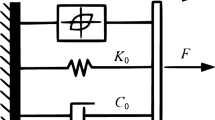Abstract
In this paper, analytical characterization of the magneto-rheological (MR) damper is done using a new modified algebraic model. Algebraic model is also more preferable because of its low computational expenses compared to differential Bouc-Wen’s model which is highly computationally demanding. This model along with the obtained model parameters is used as a semi-active suspension device in a quarter car model and the stationary response of the vehicle traversing on a rough road is obtained. The control part consists of two nested controllers. One of them is the system controller which generates the desired damping force and the other is the damper controller which adjusts the voltage level to MR damper so as to track the desired damping force. For the system controller a model reference skyhook Sliding Mode Controller (SMC) is used and for the damper controller a continuous state algorithm is built to determine the input voltage so as to gain the desired damping force. The analytical model is subsequently used in the quarter car vehicle model and the vehicular responses are studied. A simulation study is performed to prove the effectiveness and robustness of the semi-active control approach. Results show that the semi-active controller can achieve compatible performance as that of active suspension controller except for a little deterioration.
Similar content being viewed by others
References
Ahmadian, M. and Simon, D. E. (2002). An analytical and experimental evaluation of magneto rheological suspensions for heavy trucks. Veh. Syst. Dyn., 37, 38–49.
Ahmadian, M. and Vahdati, N. (2006). Transient dynamics of semi-active suspensions with hybrid control. J. Intell. Mater. Syst. Struct. 17,2, 145–153.
Choi, S. B., Lee, H. S. and Park, Y. P. (2002). H-infinity control performance of a full-vehicle suspension featuring magnetorheological dampers. Veh. Syst. Dyn. 38,5, 341–360.
Choi, S. B., Lee, S.-K. and Park, Y. P. (2001). A hysteresis model for the field-dependent damping force of a Magnetorheological damper. J. Sound Vib. 245,2, 375–383.
Crosby, M. J., Harwood, R. A. and Karnopp, D. (1973). Vibration Control Using Semi-active Force Generators. Lord Library of Technical Articles, LL-7004.
Dong, X. M., Liao, C. R., Chen, W. M., Zhang, H. H. and Huang, S. L. (2006). Adaptive fuzzy neural network control for transient dynamics of magneto-rheological suspension with time delay. Adv. Neural Netw., 3972, 1046–1051.
Eslaminasab, N., Biglarbegian, M., Melek, W. W., Golnaraghi, M. F. (2007). A neural network based fuzzy control approach to improve ride comfort and road handling of heavy vehicles using semi-active dampers. Int. J. Heavy Veh. Syst. 14,2, 135–157.
Fang, X., Chen, W., Wu, L., Wang, Q., Fan, D. and Li, Z. (1999). Fuzzy control technology and the application to vehicle semi-active suspension. Chinese J. Mech. Eng. 35,3, 98–100.
Guo, D. and Hu, H. (2005). Nonlinear-stiffness of a magnetorheological fluid damper. Nonlinear Dyn., 40, 241–249.
Guo, D. L., Hu, H. Y. and Yi, J. Q. (2004). Neural network control for a semi-active vehicle suspension with a Magnetorheological damper. J. Vib. Control 10,3, 461–471.
Lai, C. W. and Liao, W. H. (2002a). Vibration control of a suspension system via a magneto-rheological fluid damper. J. Sound and Vibration, 8, 527–547.
Lai, C. W. and Liao, W. H. (2002b). Harmonic analysis of a magneto-rheological damper for vibration control. J. Smart Materials and Structure, 11, 288–296.
Lam, A. H. and Liao, H. W. (2003). Semi-active control of automotive suspension systems with magneto-rheological dampers. Int. J. Vehicle Design, 33, 50–75.
Sims, N. D., Stanway, R., Peel, D. J., Bullough, W. A. and Johnson, A. R. (1999). Controllable viscous damping: an experimental study of an electro-rheological long-stroke damper under proportional feedback control. J. Smart Materials and Structure, 8, 601–615.
Slotine, J. J. E. (1982). Tracking Control of Non-linear Systems using Sliding Surfaces with Application to Robot Manipulations. Ph. D. Dissertation. Laboratory for Information and Decision Systems. Massachusetts Institute of Technology.
Slotine, J. J. E. and Li, W. P. (1991). Applied Nonlinear Control. Prentice-Hall Int. New Jersey.
Spencer, B. F., Dyke, S. J., Sain, M. K. and Carlson, J. D. (1997). Phenomenological model of a magnetorheological damper. ASCE J. Eng. Mech., 123, 230–238.
Stanway, R., Sproston, J. L. and El-Wahed, A. K. (1996). Applications of electro-rheological fluids in vibration control: A survey smart mater. Struct., 5, 464–482.
Stanway, R., Sproston, J. L. and Stevens, N. G. (1987). Non-linear modeling of an electrorheological vibration damper. J. Electrosta, 202, 287–299.
Sung, K. G., Han, Y. M., Lim, K. H. and Choi, S. B. (2007). Discrete time fuzzy sliding mode control for a vehicle suspension system featuring an electrorheological fluid damper. Smart Mater. Struct. 16,3, 798–808.
Wang, E. R., Ma, X. Q., Rakheja, S. and Su, C. Y. (2003). Semi-active control of vehicle vibration with MRdampers. Proc. 42nd IEEE Conf. Decision and Control, Maui, HI.
Wang, E. R., Ma, X. Q., Rakhela, S. and Su, C. Y. (2002). Modelling the hysteretic characteristics of a MR damper. Proc. Instn. Mech. Engrs, Part D: J. Automobile Engineering, 217, 537–550.
Yagiz, N. and Sakman, L. E. (2005). Robust sliding mode control of a full vehicle without suspension gap loss. J. Vib. Control 11,11, 1357–1374.
Yang, J. W., Li, J. and Du, Y. P. (2006). Adaptive fuzzy control of lateral semi-active suspension for high-speed railway vehicle. Comput. Intell., Pt. 2, Proc. Lecture Notes in Computer Science, 4114, 1104–1115.
Yi, C. (2009). Skyhook surface sliding mode control on semi-active vehicle suspension system for ride comfort enhancement. Scientific Research Engineering, 1, 1–54.
Yu, M., Liao, C. R., Chen, W. M. and Huang, S. L. (2006). Study on MR semi-active suspension system and its road testing. J. Intell. Mater. Syst. Struct. 17(8–9), 801–806.
Author information
Authors and Affiliations
Corresponding author
Rights and permissions
About this article
Cite this article
Balamurugan, L., Jancirani, J. & Eltantawie, M.A. Generalized magnetorheological (MR) damper model and its application in semi-active control of vehicle suspension system. Int.J Automot. Technol. 15, 419–427 (2014). https://doi.org/10.1007/s12239-014-0044-4
Received:
Revised:
Accepted:
Published:
Issue Date:
DOI: https://doi.org/10.1007/s12239-014-0044-4




